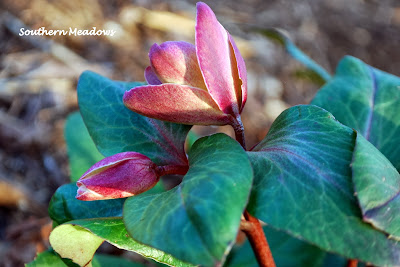W4W: Weathered
Weather Report: “Sunshine is
delicious, rain is refreshing, wind braces us up, snow is exhilarating; there’s
really no such thing as bad weather, only different kinds of good weather” ~John
Ruskin
How we all love to talk about the weather, especially gardeners. And this winter one could say the weather has been particularly unusual. So it is apropos that the Word for Wednesday hosted by Donna at Garden Walk Garden Talk is Weathered. Be sure to link over to read Donna's in depth post on our changing climate as well as to see other interpretations of weathered gardens.
I searched my photo archives for any images I had taken that demonstrate how my garden had been altered in color, texture, composition or form from exposure to weather. It was more challenging than I anticipated. What I did find were some more artistic expressions of "weathered" in nature.
The hosta leaves that were hit by a hard frost earlier this month begin their decay but still provide interesting shapes.
Some old, weathered bird houses in a friends garden have seen better days but provide pops of color.
This picture was taken this summer in Pascagoula,
Mississippi near my in-laws farm. The cypress trees found in the swamps
along the coast provide protection against erosion and flooding in this area. These
forested swamps are like a "speed bump" for the storm surge caused by
hurricanes.
These roots near Falls Park in Greenville,
South Carolina have been exposed from years of erosion and weathering.
People have also left their mark with carved graffiti on the bare roots.
You can check out an interactive image of this Medusa tree here.
I love the creative elements that are naturally produced in gnarled limbs, fallen trees and stumps giving them a worn appearance.
A wasp hive, long abandoned, sits amongst the fallen leaves to decay and return to nature provides some interesting texture to the winterscape.
While the snow and cold altered the structure of the fungi on this fallen tree making them sag and droop giving them a tatty look.
Freezing temperatures created a shear of ice on parts of this flooded area in a Michigan park we visited over our Christmas travels to my family. Living in the south I don't often see both ice and water like this. It is beautiful.
When we visit in summer we spend a lot of time along the Lake Michigan coast which is made up of sand dunes. These dunes are constantly eroding due to winds blowing shoreward at up to 25 mph.
Lichens, fungi, mosses, grasses, wildflowers, shrubs and trees are all part of the dunes ecosystem. These plants have evolved to adapt to the harsh environment. The dune grass helps hold the sand in place and protect from the wind erosion.
This time last year north Georgia was covered in a blanket of snow. December this year has been much milder with temperatures a good 10 degrees or higher than average. These extremes really create unpredictable conditions for plants. I have plants blooming already that under normal conditions don't bloom until February.
Japanese Flowering Apricot
Hellebore
How does your weathered garden look?















.png)
